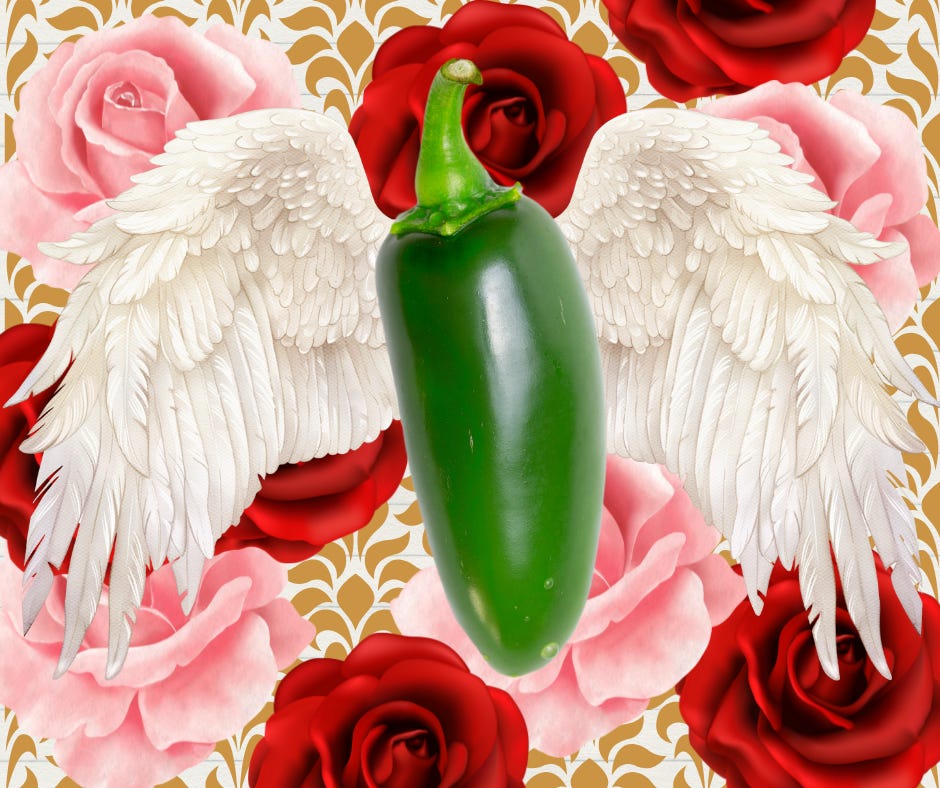Racial Anorexia: Recovering From "Racial Restriction" In Colombia
Examining my eating disorder through the lens of race & metaphor.
Welcome to the sixth installment of my Substack vertical, VOLUMINATI. This vertical is a monthly series of experimental audiotextual (audio + text) essays. The full essay is available for paid subscribers. You can listen to this month’s edition by scrolling all down to the bottom of the article and hitting play.
Content note: I will be discussing my history with anorexia and connecting that to my history with fatphobia and racism; there are no specific ED behaviors described beyond general references to food restriction.
This article is dedicated to all the women who have helped me understand my own Latinidad. Most recently: Mar Ortega, Valeria Campos, Julia Martinez Estrada, and Pilar Londoño.
Part 1: Preparing For My Trip to Colombia
I’m the type of person who plans trips while she’s at the airport waiting for the flight that will take her on that trip. Recently, though, I found myself preparing for my May 2025 trip to Colombia for the Bogota International Book Fair in March.
I hired a Peruvian tutor to help me improve my spoken Spanish. I began listening to Spanish language music, and talking to my rabbits in Spanish with the undulating tones and superlative nicknames that many Latin parents bestow upon their children: “my sky,” “my queen,” “my love.” Words that my grandmother used to speak to me. I couldn’t wait to be surrounded again (as in childhood) by people who speak Spanish and have familiar ways of seeing the world (like, the way that many Latinos seem to have a casual relationship with ghosts and/or curses).
Clearly there was something deeper to explore about my enthusiasm heading into my trip to Colombia.
I realized that what made the lead-up to this trip different was that I saw it as an invitation to fully embrace, anticipate and enjoy my Latinness — an invitation I don’t feel in my daily life. I was creating and relishing opportunities to immerse myself in Latinidad way before I even arrived in South America.
Part 2: What Is Racial Anorexia?
I am the product of a common American paradox. I’m the girl child of a Mexican immigrant family whose greatest wish was that I would speak English perfectly, go to college, have a good job, and marry a man who had blue eyes. That is, full and total assimilation into American white-dominated society.
However, I grew up in a home where Spanish was spoken primarily, in a neighborhood full of people who weren’t from the United States, where exactly zero of our neighbors had blue eyes. My family’s kitchen smelled of piquant chili and earthy tortillas. There was an Aztec calendar that hung above the counter, and it was in that kitchen that I learned to crave things like tamales, enchiladas and menudo (a soup, deemed “strange”… ok, “gross”… by American standards, which includes the delicious, chewy honeycombed lining of a cow’s stomach, the perfect sponge for flavor and for flecks of oregano). Even my family’s matriarch, my grandmother (who raised me) possessed a deeply pained, melancholic and soapy Victorian femininity. This gender performance was the opposite of the repressed white femininity I saw (and longed for!) on TV. The sad girl energy of my grandma is not uncommon for Mexican women of a certain age, and all the literature on the issue seems to indicate it’s a hangover from 1800s Spanish colonialism.
To return to the paradox: How the hell was I meant to develop an appetite for apple pie and being stoic when I was being fed tripe and my mother figure was weeping openly on a daily basis? How was I supposed to want to be with someone with blue eyes, if everyone I loved had brown ones?
I don’t know if my grandparents believed that some kind of harmonious duality was possible, like a “real” American girl who just happened to eat “weird” parts of a cow? I, however, didn’t feel like these two parts of me could co-exist peacefully.
It felt like the terms of American assimilation were all or nothing.
Deep in my grandmother’s expectations for my future was hidden an invitation to “de-Latinize:” to hide myself, my home, the tortillas, the menudo, the Spanish, and even her. Her expectations of my de-Latinization mapped onto cultural norms of American assimilation. These norms expect BIPOC to lessen or minimize our bodies, desires and behaviors in order to be perceived as non-threatening. This is its own type of fatphobia. In response to this, over time, I developed a type of racial anorexia.
By “racial anorexia” I mean:
a type of sustained abstinence from meaningfully recognizing myself as Mexican and loving my Mexicanness
a sustained abstinence from seeking opportunities to feel mirrored or spiritually nourished as a racialized person
a sustained abstinence of racial practice and meaning-making that was bred of the terror that I might not become fully assimilated into white culture
and the fear of my own racial fullness
I learned to restrict my racial-ness in order to meet both my family’s and the culture’s expectations. As someone who also struggled with (undiagnosed) clinical anorexia, I don’t know which came first: the part of me that believed food was dangerous or the part of me that believed being Mexican was dangerous. Either way, these twin fears informed one another in ways I’m still trying to unravel.
Part 3: Seeking Racial Satiety
My enthusiastic preparation for Colombia was a response to that compulsion to de-Latinize. Instead of de-Latinizing, I was re-Latinizing. This “re-Latinization” became a way of nourishing myself, feeding my racial self in a way I normally don’t because of all I’ve just mentioned.






